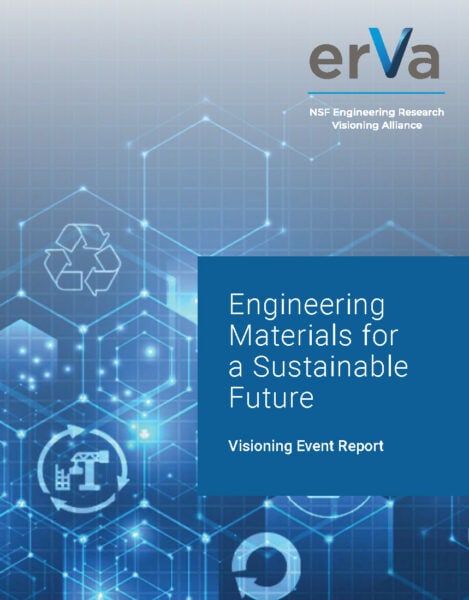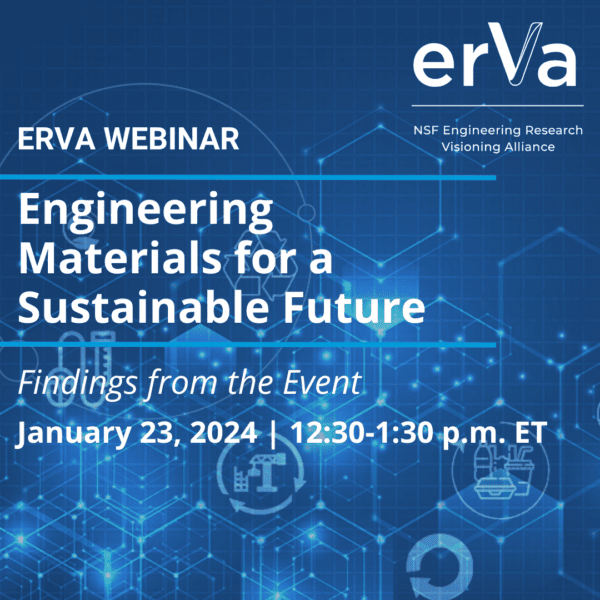Engineering Materials for a Sustainable Future
Exploratory Domains
There is an urgent need to bring breakthrough materials research and development to the forefront of current sustainability efforts. Recent government action in the U.S. and globally has galvanized industries to pursue zero-carbon status. Corporate investors are also increasingly voicing interest in the development of sustainable materials solutions to enable a circular economy. This visioning workshop will unite researchers, industry leaders, policymakers, and investors to articulate materials engineering research priorities. This visioning event takes a holistic approach to discussing sustainable materials from the design stage, through scale-up and manufacturing, to the end-of-use scenarios for three key industries: chemical manufacturing, construction, and single-use consumer products.
Chemical manufacturing comprises ~40% of the GDP and is critical to creating fuel, fertilizers, plastics, pharmaceuticals, and many other necessary compounds. Yet, most catalytic reactions generally operate at high temperatures by burning petroleum fuels, generating significant greenhouse gas emissions and undesirable byproduct formation. Achieving precision chemistry, where reactions are simultaneously high-yield, product selective, and free from greenhouse-gas emissions, will be critical for a sustainable future. In parallel, the materials used in construction, such as steelmaking globally, account for ~3.8% of the GDP and ~8% of CO2 emissions, while concrete and cement account for an additional 8% of global CO2 emissions. While they are low-cost to produce, they are not easily recyclable. Balancing cost and performance while decarbonizing the processes to make construction materials is essential to achieve a zero-carbon future.
Finally, polymer chemistry provides us with cheap, durable, and customizable multilayer materials for a variety of single-use consumer product packaging; yet these attributes have given rise to massive waste accumulation and catastrophic greenhouse gas emissions. Biobased, compostable alternatives to traditional plastics rarely have equivalent functionality to their petroleum-based counterparts. Furthermore, energy-efficiency recycling methods for mixed materials waste streams remain an obstacle. In each of these industries, new materials utilizing renewable energy, renewable feedstocks, state-of-the-art chemistry, physics, synthetic biology, and artificial intelligence are required to enable net-zero or negative greenhouse gas emissions, increased recyclability/composability, and progress towards fully circular materials economy.
Sustainable Material Design
Sustainable material design refers to the development of materials and products that minimize the negative impact on the environment and human health. The use of sustainable materials in design is becoming increasingly important as we face challenges such as climate change, resource depletion, and pollution. Sustainable materials can also be designed to have a longer lifespan, reducing the need for replacement, and minimizing waste. Overall, sustainable material design is an essential component of creating a more sustainable future, and designers have a crucial role to play in developing innovative solutions to environmental and social challenges.
Manufacturing & Scale-Up of Sustainable Materials
Scaling-up sustainable material manufacturing involves increasing production to meet demand while maintaining these sustainable practices. To scale up sustainable material manufacturing, companies can invest in research and development to improve the efficiency and effectiveness of sustainable production methods. This can include finding new ways to recycle and reuse materials, developing more sustainable supply chains, and optimizing production processes to minimize waste and energy use. Sustainable material manufacturing also requires collaboration and partnerships across industries and sectors. This can include working with suppliers and customers to promote sustainable practices and educate consumers about the importance of sustainable materials. Overall, scaling up sustainable material manufacturing is essential for creating a more sustainable future. By adopting sustainable practices and investing in research and development, companies can produce materials and products that meet growing demand while minimizing the negative impact on the environment and human health.
Sustainable Material End-of-Use and Reuse
Sustainable materials end-of-use processes and reuse refer to the handling and disposal of materials and products at the end of their useful life in a way that minimizes waste and maximizes their value. Sustainable materials end-of-use processes are an essential component of the circular economy, where materials are kept in use for as long as possible. To promote the reuse of materials, companies can design products with end-of-use in mind. This can include using materials that are easily recyclable or designing products that can be easily disassembled and repurposed. Overall, sustainable materials end-of-use processes and reuse are crucial for creating a more sustainable future. By adopting sustainable practices, companies can reduce waste, conserve resources, and create new economic opportunities.
Co-Host

Timeline
-
April 2023Established
-
July 2023Visioning Event
-
Winter 2023View Final Report
Thematic Task Force
Co-Chairs
Jennifer Dionne
Stanford University
Blake Simmons
Lawrence Berkeley National Laboratory
Carol Handwerker
Purdue University
Greg Wellman
Eastman
Kimberly Kurtis
Georgia Institute of Technology
Laurent Matuana
Michigan State University
Rainer Kolb
ExxonMobil
Sridevi Narayan-Sarathy
PepsiCo










